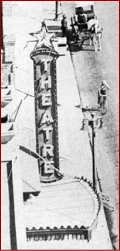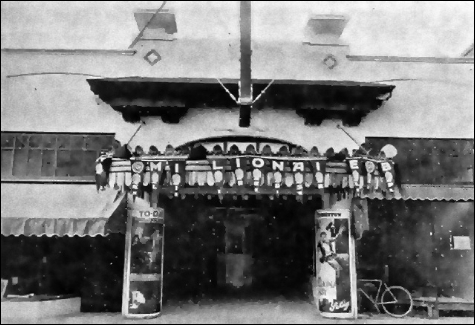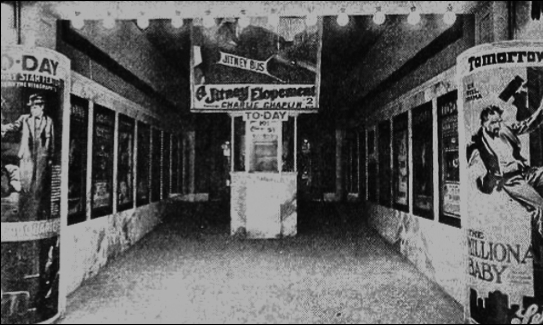The Nickelodeons
In 1976 when Peter Bogdanovich filmed a movie about the early "flickers," he called it "Nickelodeon" and, for some forgotten reason, chose Modesto as the filming location. Considering that just over the hill in the Livermore Valley, the city of Niles is where Charlie Chaplin invented his iconic "tramp" character, it is a surprise that Bogdanovich dragged Burt Reynolds, Ryan O'Neal, Tatum O'Neal, Brian Keith, Stella Stevens and John Ritter to the Central Valley. Perhaps the director had been influenced by George Lucas' 1973 "American Graffiti." Bogdanovich filmed in the old ice house on 9th Street, which he converted into a sound stage, and made a movie that, once released, was quickly forgotten. Perhaps the filmmaker was drawn by the memories or ghosts of Modesto's earliest picture emporiums that still lingered on 10th Street. Those ghosts and memories are filled out a little bit here. One of them even offers us historical photographs to ponder well over 100 years later.
THE ISIS and THE DREAMLAND THEATERS (Early 1900s)
10th Street
While not truly "nickelodeons," these theaters were performance spaces as well as movie houses. When one considers the one reel or two reel films being offered, the two theaters fit the bill. The Isis seated 600 and had a picture change each day. Films were advertised as "licensed and consorted." Added to the new film medium's draw and no doubt to help attract and hold an audience, vaudeville shows were often included on stage with trapeze artists, acrobats, dancers and singers. Admission was 10 cents. The Dreamland Theatre had "exits and ventilation" and "gave away two five-pound boxes of Sugar Plum Bon Bons each week. Each night from 7 to 10:30, there were continuous short films and on the weekend, matinees were scheduled. Admission was also 10 cents.
One could imagine the likes of Fatty Arbuckle, Mabel Normand and the Keystone Kops or Ben Turpin and Buster Keaton projected on the makeshift screens, dazzling the population as this new mode of communication, barely out of infancy, took the town by storm.This period is well before the establishment of Hollywood and its studios in Southern California. At the time, most film studios were based in New York City, with Mack Sennett (and his Bathing Beauties), Charlie Chaplin, D.W. Griffith and Mary Pickford at the head of the pack.
THE STAR (Opened October, 1911)
927 10th Street, later 928 10th Street
 Besides its distinctive marquee, the Star also boasted the fact that it was designed by architect Bernard Joseph, designer of the Arch and the Hotel Hughson. The Star was described as, "the cleanest, neatest, safest playhouse in Modesto." It had 372 seats, placed 29 inches apart for "complete comfort," plus ventilation provided by two 15-inch suction fans and two other electric fans, probably very important in the summers when temperatures could be stifling. By 1915, as grand as this theater was, it had moved across the street to a new location, where retail shops would later be housed.
Besides its distinctive marquee, the Star also boasted the fact that it was designed by architect Bernard Joseph, designer of the Arch and the Hotel Hughson. The Star was described as, "the cleanest, neatest, safest playhouse in Modesto." It had 372 seats, placed 29 inches apart for "complete comfort," plus ventilation provided by two 15-inch suction fans and two other electric fans, probably very important in the summers when temperatures could be stifling. By 1915, as grand as this theater was, it had moved across the street to a new location, where retail shops would later be housed.
The photographs above show the theater after the move. Both films clearly advertised were released in May, 1915. Of particuclar interest is the fact that Charlie Chaplin filmed "A Jitney Elopement" in Niles, California and Golden Gate Park in San Francisco. Niles boasts that Chaplin created the "Little Tramp" character in that community and houses a museum of silent film.
The photograph on the left shows the Star Theater's electric sign which rose above the marquee. The sign has a star perched on top of it. Archives of the Modesto Evening News show that the New Star Theater opened on July 5, 1915, under the management of a Mr. William R. Martin, who would later manage the Modesto Theater. Information is scarce but the Evening News praised it for its ventilation system. As stated above, the Star Theater was previously located across the street at 927 10th Street. Most historians date it from 1911, but a statement on the website, Cinema Treasures, says, "This previous Star Theater can be traced back to at least 1896 in the Modesto Evening News."
The New Star Theater closed sometime in 1921. On February 11, 1922, it was announced that the lease on the New Star had been transferred and the remodeling of the former theater into three stores would begin. The building still stands in downtown Modesto, but is available for commercial purposes.
It is also interesting to note that the original owner of the Star was A. A. Richards, who was considered by Tinkham to be "a theatrical manager of experience and at one time owner of the Modesto Star theater." Since the original name of the Covell Theater, built in the early 1920s was the Richards, one could assume, without a great deal to support it, that Mr. Richards broke off to build his own house. The name did not remain for long, though, as the Covell was subsequently known as the National, the Princess and then the Covell.
The Star Theater - Front View
The picturesque exterior of the Star Theater. This is most likely the location at 928 10th Street, where the theater had moved after giving up its initial location across the street. The designer of the theater, including the busy facade, was Bernard Joseph, architect of the Modesto Arch and the Hotel Hughson. | The Star Theater - Lobby and Ticket Booth
Typically in early movie houses, the ticket booth and lobby were open to the outside and adorned by multiple posters of current and upcoming films. Advertised on the right is a 1 hr. film, The Millionaire Baby, showing tomorrow. A 26 min. Charlie Chaplin comedy "A Jitney Elopement," filmed in Niles, California, is currently running. |


